Itinerary edited by the UNIVERSITY OF BARI 

Samples of the Museum of Earth Sciences selected for this path belong to a collection of ornamental stones used for making buildings and tools, particularly expressive of the geological peculiarities of the territory.
In Puglia, the use of stone has ancient and prestigious traditions coming from the Palaeolithic flint quarries on the Gargano to Lecce’s Baroque, whose aesthetic owes so much to the unique features of the carved stone. Even in rural areas, the use of the stone draws the landscape as you can see in the dry stone walls and the “trulli”, in the “pignon” buildings, in the “masserie” and in the castles and finally in the most current buildings.
Significant were the environmental and social implications of the mining activity of the ornamental stone, which has had wide circulation in the last 150 years, producing a series of damage to the landscape. The legislation has put the situation under control, but deep scars remain to mark the territory. From a social point of view, the limits imposed by legislation on this market have prompted the drastic reduction of this activity of crucial importance for the sustenance of a large portion of the apulian population.
An extremely ancient history
Since the Paleolithic, by the time of the first documented colonization of Gargano, the Apulian territory has provided to man the raw materials to achieve their stone artefacts, choppers and scrapers. Lithic industries of subsequent ages have spread throughout the country.
Since Neolithic times, always in the Gargano, it is testified the systematic estraction of flint. The underground quarry of Defensola, near Vieste, is the first example in Western Europe of how man, with rudimentary picks and mallets (also chert) and the help of stone lanterns, extracted the flint, a raw material so important to encourage the development of those peoples.
From the age of copper, flint probably has urged the development of organized economic activities also to exploit it.
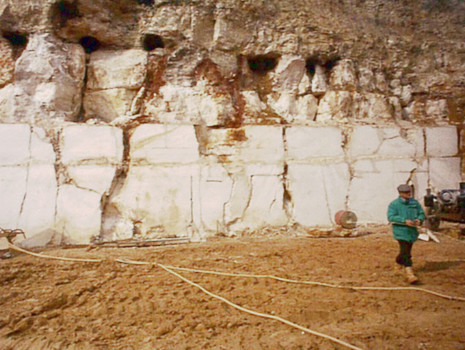
As you can well understand, therefore, the habit of using the stone has very deep roots in human culture of Apulia. It seems that it belongs to it since its first steps on this unique land full of contrasts and colors that are reflected in the same variety of rocks. The color, the texture and very different technical characteristics of the rocks, always compatible with the essential human activities, encouraged the flourishing of mining activity in Apulia. In general, it has always had the following characteristics: the ornamental stone or "marble" comes from the districts of Bari and Foggia; the limestone or 'tufo' comes mostly from Lecce district and, secondarily, from the districts of Bari, Taranto, Brindisi and Foggia; the calcareous material for aggregates comes, mostly, from all districts of the region.
Among the early writings concerning the mining of stones in Puglia are those of Michelangelo Manicone, Friar Minor Observant of the Province of St. Angelo (Prov. Foggia), at the turn of XVIII and XIX century, complaining abaut the lack of general consideration of the Gargano stone, while so compact and beautiful for color and texture.
With regard to the Mesozoic limestone (135-64 Ma from now), numerous are the architectural elements of the territory that distinguish the Apulian landscape: the dry stone walls and the “trulli”, the “pignon” buildings, the “masserie” and the castles, to reach the most current buildings. All architectural structures are the expression of the work of generations of farmers and shepherds who used the stone adapting it to their needs, becoming real miners. They have built a heritage with the original characteristics of all apulian people, so linked to their territory, which makes the life hard and rough, but that brings the typical dignity and pride of men and original peasant.
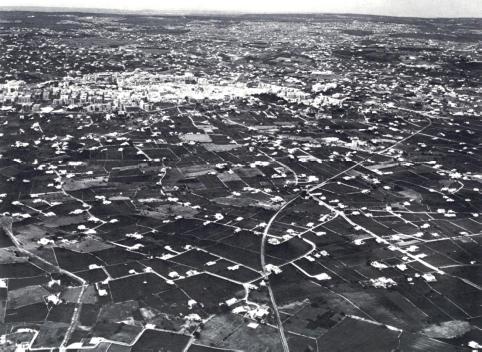 The dry stone walls
The dry stone walls 
In I.G.M.I. cartography with the scale 1: 25,000, you can clearly read the countless kilometers of dry stone walls of the Gargano, Murge and the Salento Peninsula. Built with local stone, they often reach a development of 6-8 km, up to a maximum of 14 km, and an area of one square kilometer. The dry stone walls border the streets, surround smaller and smaller cultivated areas like stockyards (jazzi), identify small watersheds, resident in the castle steep slopes. They represent a barrier against the wind action on the ground, reducing the evaporation of water contained in it; protect vegetables, young plants and leefs. They prevent the erosion of the diluvian waters.

During the hot and dry season, when the worm weather is prolonged, the dry stone walls catch the condensation water and transfer it to the plants through the soil, a modest but enough to supply.
This form of water supply was already recommended by Abraham, in his native land, Mesopotamia, where were already in use “trulli-like” houses.
Trulli

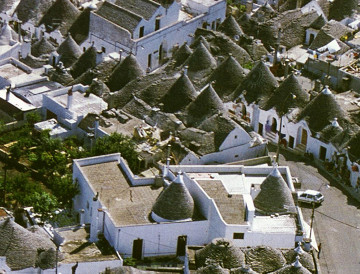
They are present in all part of Apulia region with special shapes and uses that change with geographical location. The various types differ mostly for the lower part that may assume, depending on the zone, as cylindrical shape or parallelepiped or cubic. The coverage is almost always to "cone". It is mainly made of the famous "chiancarelle", coming from the plate-like elements of limestone outcrops of higher horizons of the formation of the "Limestone of Bari", that "trullari" feature into smaller and smaller circular courses up to the vault key.
Girolamo Acquaviva of Aragon (1600-1665), known as "Guercio", Count of Conversano, seems that had prohibited the use of mortar to avoid the tax imposed by the King of Naples on new construction. In the case of inspections the houses could have been disassembled and rebuilt in a short time.
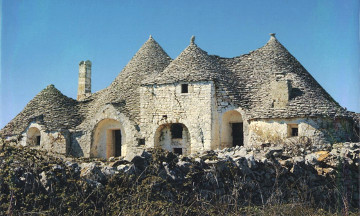
Similar buildings like trulli have been traced to Egypt, Mesopotamia, Greece, Dalmatia, Sicily and Sardinia. Some of these date back to the third millennium BC. It’s very likely, therefore, that this is an imported construction type.
In Puglia, the first documentary evidence clearly indicate the presence of trulli dating back to the XIV century, but only from the mid-sixteenth century these buildings were converted into permanent houses.
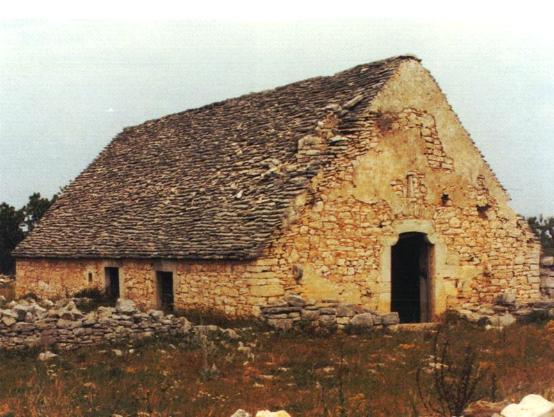 Buildings "pignon-like"
Buildings "pignon-like"

There is another model building in Puglia, perhaps least known of the trulli, which has characterized our territory: the “pignon”, with another architectural form differently conceived from the trullo and that could have more ancient origins. It had a remarkable expansion with the phenomenon of transhumance. Many of “jazzi” (stockyards) and farms of Puglia between the seventeenth and nineteenth century contain construction pignon-like.
Equipped with high dimensional variability, the "pignon" or "Ląmia" (name local) have stone walls with a double masonry, often built without mortar, and a gable roof, steep and covered with chiancarelle. The building has a rectangular plan and the static function of the artifact is performed mainly by the walls arranged on the major sides, while those recorded on the minor sides have the prerogative to act as "tompagni".
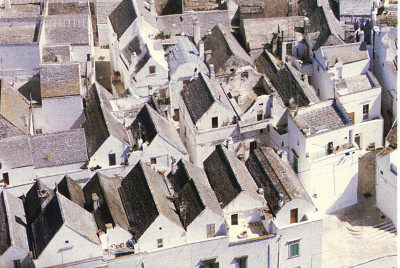
The solution to pignon was adopted by many churches and chapels (for example the church of “Santa Maria della Greca” and the church of “St. Anne under the walls” in Locorotondo and the church of “St. Nicholas of the Greeks” in Martina Franca).
The module pignon was also the generating element of many of the ancient structures that characterize the urban centers of Locorotondo, Cisternino and Martina Franca and, remaining in the territory of "Murgia dei Trulli", is a construction phenomenon that covered the city of Putignano and Noci.
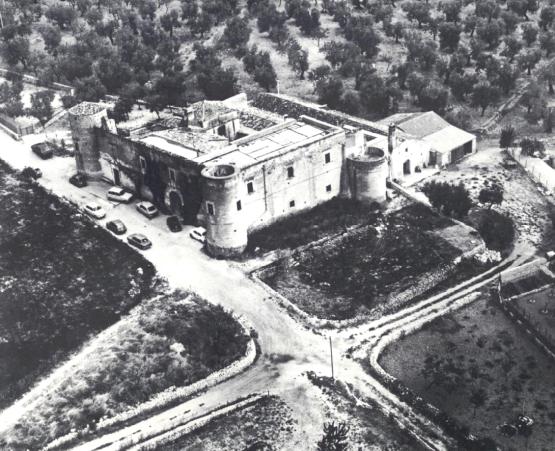 Farms
Farms

One of the peculiarities of the Apulian countryside is the farmhouse. A kind of autonomous citadel, located in a strategic position and with defensive capabilities, accessible through uncomfortable “tratturi”. Its present form comes from the fourteenth century. In the farm all revolves around a large courtyard, one side of which is taken from the house of the owner (and later of the custodial farmer). The courtyard is flanked by a series of functional service areas for the activities of the farm. The emerging core of the whole complex is the part allocated to housing with the church or chapel which often is connected, that, between '700 and' 800 has undergone the most significant structural change. The cessation of the need to have defensive elements (in this case we speak of a real "fortified farm") it has gradually expanded and embellished with loggias, terraces, external monumental staircases and frescoed halls, taken in outer space with statues, fountains and pergolas.
Below: Masseria Cocevole (Gioia del Colle - Ba), nineteenth century. Decorative elements play an intimidating and defensive function. In the detail photo you can see the water drains rainwater with cannon-shaped mouths, instead through the mouth of the apotropaic masks and rosettes was possible to put the rifle barrel. (Photo for courtesy of Proloco Gioia del Colle).

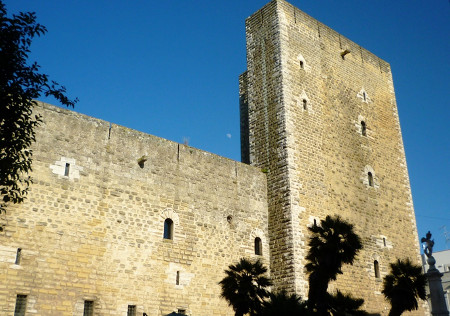 Castles
Castles

Built in Apulia for the first time by the Normans, in the early eleventh century, castles reflect in their characteristics and architectural expressions varieties of stone materials in Puglia. Trani Castle has walls of limestone blocks, slightly built with ashlar quoins; Bari Castle, built by the Normans at the beginning of the twelfth century, has the blocks made of “tufo”; the Red Castle of Brindisi, erected in the XV century for defense against the Turks was built with blocks of reddish "carparo"; finally the Castle of Lecce, enhanced by the fine workmanship of the "Lecce stone".
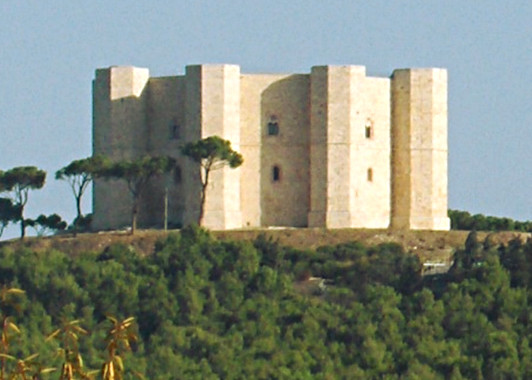
Symbol of the Apulian castles, the thirteenth century Castel del Monte was carefully built with large blocks of solid limestone of yellowed ivory-white color, with a portal and windows finished with a coral breccia recover in the surrounding areas.
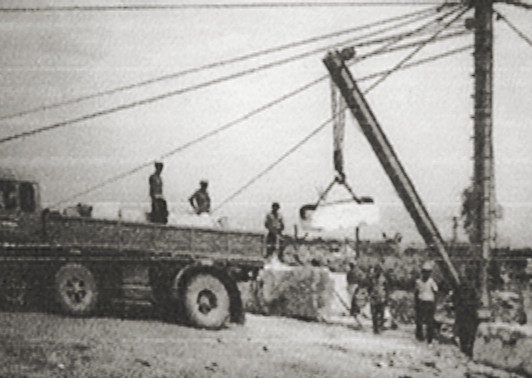
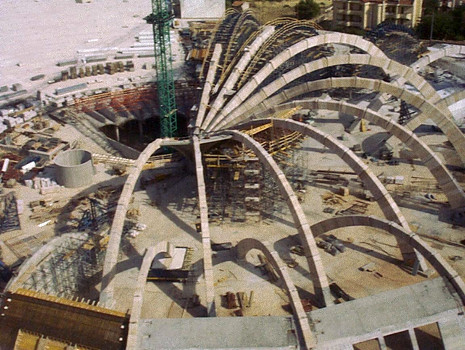
Story of a difficult market
Leonardo Cera (1791-1848), a native doctor and geologist S. Marco in Lamis, a great lover of ornamental stones, went through all the Gargano and gathered samples of "marbles" and alabaster in a rich collection which was later sent to the Universal Exhibition Paris in 1900.
In support of his studies the Prof. Leopoldo Pilla (1805-1848), geologist and Curator of the Museum of Natural Sciences of Naples, first described the minutely quarries and "marble" of Gargano territory, including " the most beautiful marble breccia "ever seen, found in King's quarry, and widely used for the upholstery of the Royal Palace”.
The first attempts to start commercial mining activities are documented in the Gargano. In Florence on the 14th December 1867, laid the legal and administrative basis for the establishment of a "Society for the purchase, extraction, processing and sale of marble and alabaster existing in the mountains of the Capitanata, and [that] will be called Anonymous Society Gargano " (in “Marble and alabaster in Gargano”, Giuseppe Soccio 2003). The company, however, had no luck and the attempt of the economic value of the Gargano was extinguished before it began.
However, there are famous examples of the use of the Gargano stone, from extraction to implementation of the limestone of Apricena. The stone once again has been the protagonist in the creation of a work that will remain in history: the Church of St. Pio of Pietrelcina, designed by Renzo Piano and inaugurated on 1 July 2004.